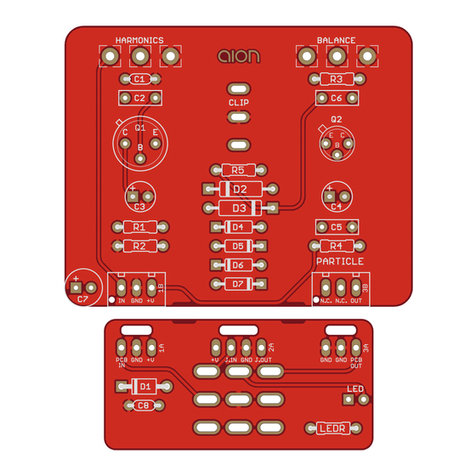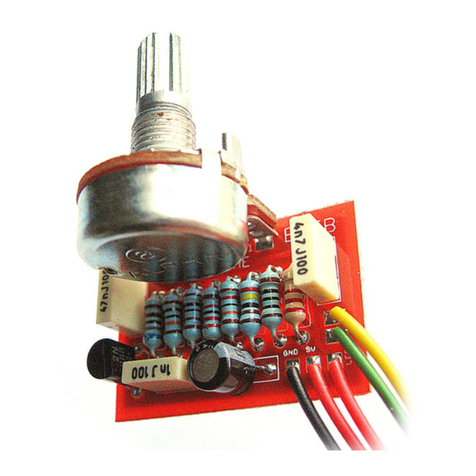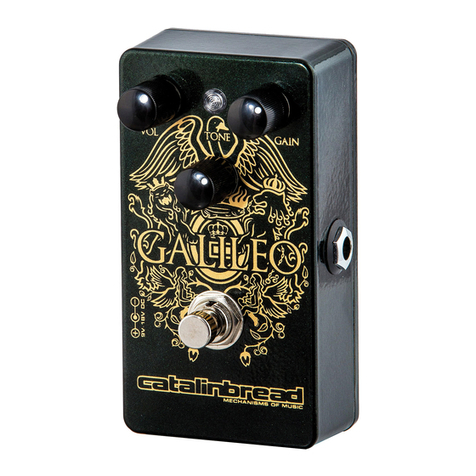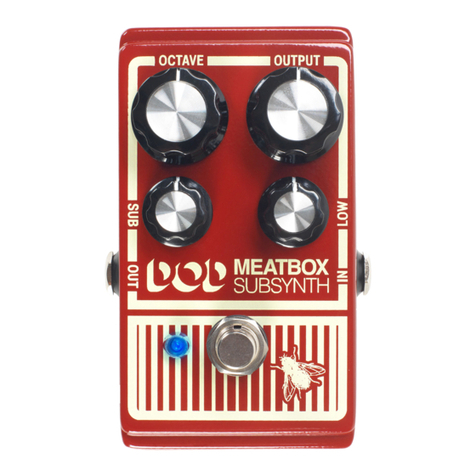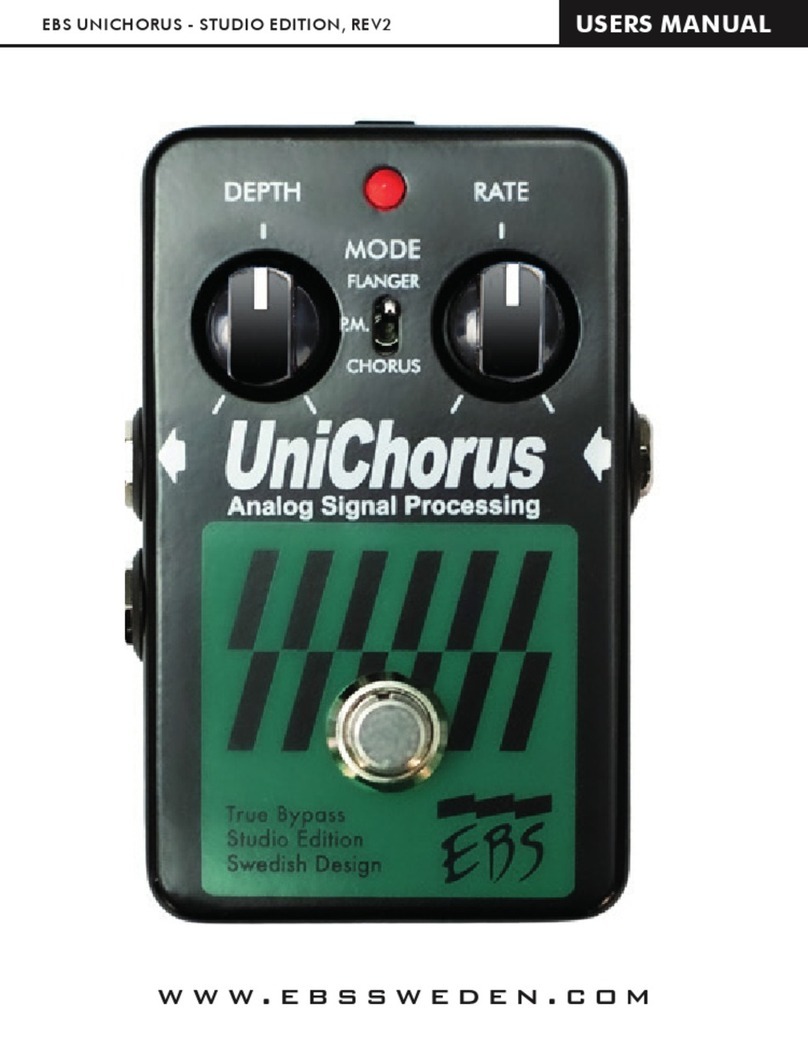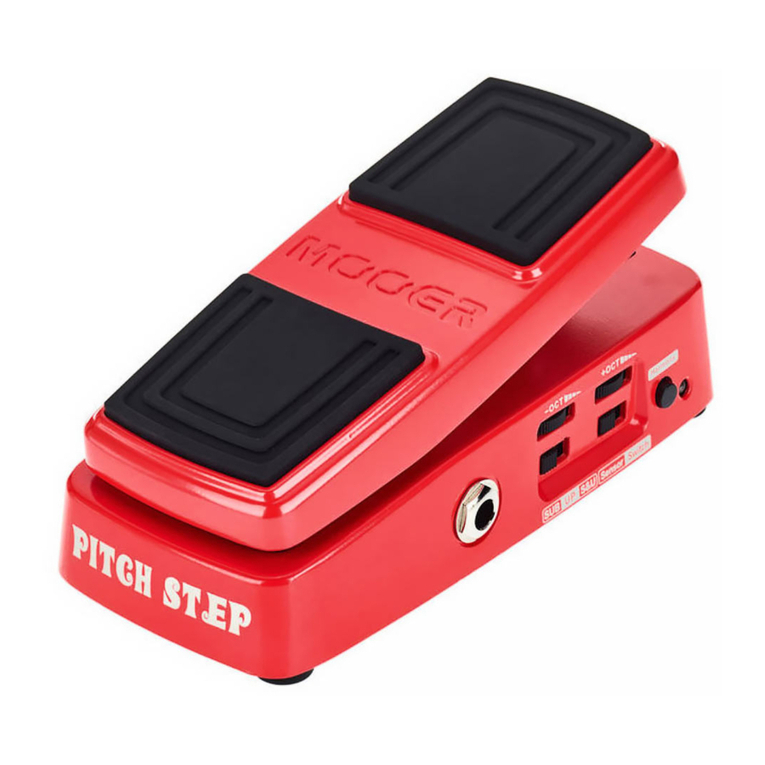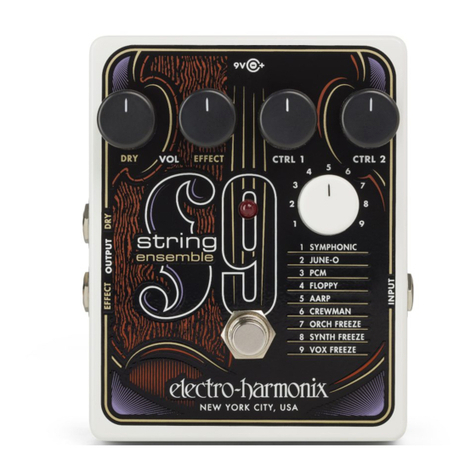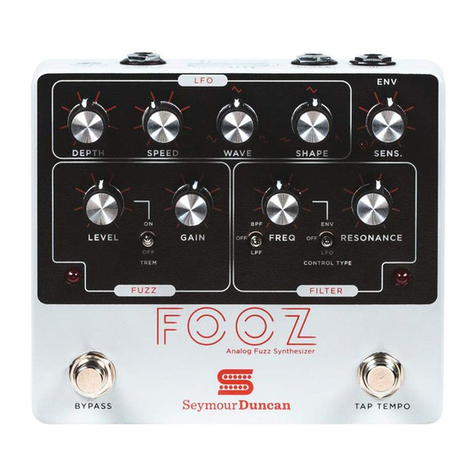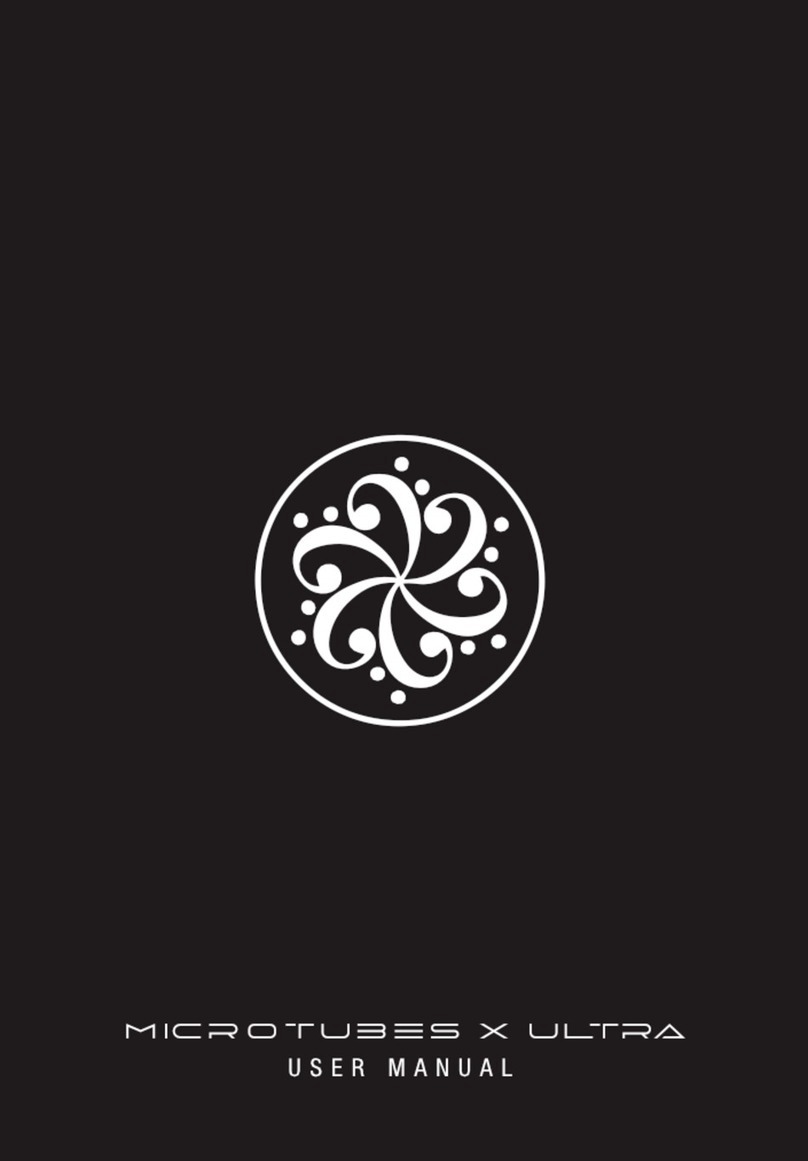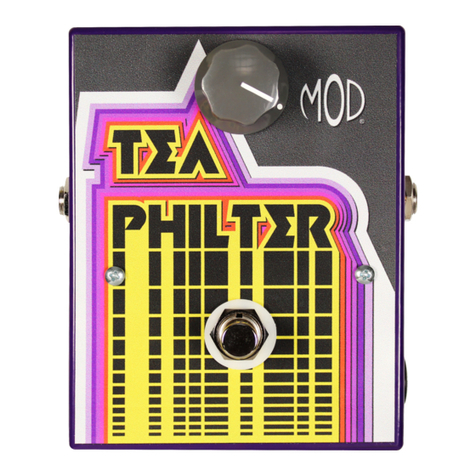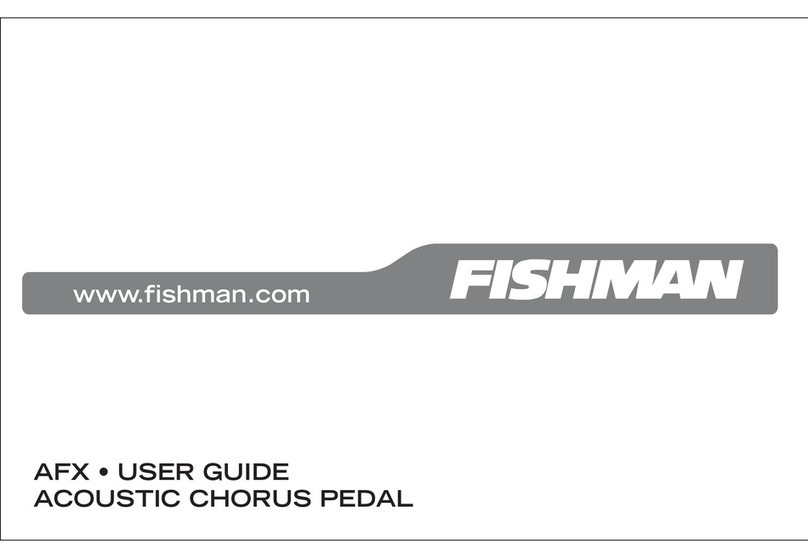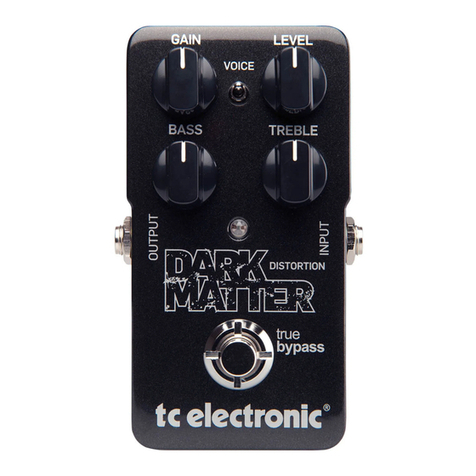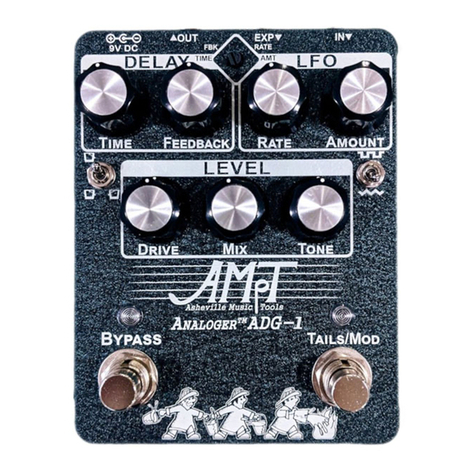Gig-fx PRO-CHOP User manual

PRO-CHOP
Operating Manual
PATENTS PENDING WORLDWIDE

2
Electrical faults can kill you.
In the music world, the most common form of electrical shock
occurs when the musician forms a path for an electrical current
between two different circuits where one of them is faulty. Usually
this is caused by holding a guitar plugged into one circuit and
touching a microphone which is plugged into a different circuit. If
one of the circuits (or a piece of equipment in the path) is faulty,
there is a real danger of electrical shock.
gig-fx pedals offer the possibility of working in stereo using two
amplifiers. If one of your amplifiers is connected to a different
electrical circuit from the other, you need to make sure that both
circuits are wired correctly. Use a “mains tester” from an electrical
or hardware store to test the mains outlets. It should indicate that
the “Live” (Hot), Neutral and Ground are all present on the correct
pins.

3
NEVER USE outlets which are not wired correctly. If you have
ANY doubt at all, please call an experienced electrician.
In addition to the above, make sure your amplifiers are wired
correctly and have not been modified by inexperienced personnel.
Beware of amplifiers that have switches that reverse polarity or
“ground lift”connections. When touring in foreign countries, make
sure your amplifiers are set for the correct voltage. If you use a
transformer to change the mains voltage from 110VAC to 220VAC
or vice versa, use a mains outlet tester to make sure the output of
the transformer is correctly wired and the ground is connected.

4
What to expect
The PRO-CHOP will challenge your imagination and creativity.
Unlike the myriad of ―me too‖ effects out there, the PRO-CHOP
can produce TOTALLY ORIGINAL sounds. For example, the PRO-
CHOP can generate a sound that captures the richness and
texture of a multi-tracked delay but without the repeated note
hanging on. Given the wide variety of settings, you can achieve
unique sounds that will define your song or signature sound.
The PRO-CHOP can also reproduce best-in-class classic sounds
such as a tremolo, rotating speaker, or the chopped sounds, which
up until now were only associated with synthesizers. But on top
of all this, the PRO-CHOP can produce never-heard-before sounds
that will inspire you to write the effects into your original
compositions. Sync it up with your PC recorder or a MIDI beat and
you can create some unbelievably cool grooves in no time.

Hooking it up
If you use a lot of gain, it is better to put the PRO-CHOP last in
the chain of effects. This will retain the signal-to-noise ratio.
HOWEVER, the PRO-CHOP can be followed by note-triggered
effects to create some amazingly funky sounds.

6
Ground loops (the kind of buzz you don’t want)
Sometimes, when working in stereo, an annoying hum or buzz will
appear when two amplifiers are used. This can occur when the
amplifiers are plugged into two separate circuits, or if either of the
amplifiers has some internal wiring issues, or if the large ground
loop forms an antenna. Test the mains outlets using a mains tester
as described in the safety warning in this manual or call an
electrician to test the outlets.
Once you have verified that the outlets are wired correctly, you can
usually solve the problem by disconnecting (“lifting”) ONE of the
grounds on the amplifier circuits (NOT BOTH –IT IS DANGEROUS
TO PLAY WITHOUT ANY GROUND AT ALL). In the US, you can
do this by using a “ground lifting” plug which eliminates one ground
connection. In Europe or elsewhere that uses three-pin plugs, you
may need to use a specially adapted plug that does not have a

7
ground connection. Consult an electrician first if you need to
modify any 220V mains connections. 220V is a deadly voltage.
In conclusion, providing that one of the amplifier grounds is still
present throughout the circuit, it should be safe to lift one of the
grounds and any ground-loop buzz should buzz off.
Powering it up - AC Adapter
The preferred adapter is a regulated 9V DC supply class 2 adapter
with minimum 50mA output current capability. Most
commercially available 9V adapters designed for pedal effects will
work (2.1mm diameter plug)). No harm will come to the unit if
the power supply jack has the wrong polarity, but double check
that the center-pin of the power jack is negative polarity.

8
Battery Power
The unit can be operated on a single 9V battery and will be ―on‖
and drawing current as long as there is a ¼‖ jack plug inserted in
the input jack socket. To replace the battery, unscrew the
smaller base panel underneath the unit. When the battery is
running low, the unit may fail to turn off because of insufficient
current to drive the optical switch.
The PRO-CHOP draws around 30mA, which will give a reasonable
battery life. However, it is recommended that you use a power
adapter on important sessions or gigs. Be aware that if your
power supply does not supply enough current to power all your
effects, power-supply noise can increase substantially or cause
other unwanted sound defects. To preserve battery life, always
unplug the input jack when the pedal is not in use.

9
Pedal Board Mounting
Attach strips of self-adhesive Velcro sufficient to cover the rubber
pads on the base plate of the pedal. Do not put Velcro in the
middle of the pedal base plate as it will stress the plate if the
pedal is ever removed from the pedal board. Cover your pedal
board with matching opposite strips of Velcro et vôila!
By-Passing the unit
The unit is by-passed if the pedal is in the full-back position. You
will not feel any switch as it is a noiseless, wear-free optical
switch. The effect will turn on when the pedal is depressed.
When bypassed, neither the Chop nor Pan LED will be illuminated.
Please note, even when by-passed, the pedal will draw current as
long as there is a jack plug inserted in the input jack socket, so,

10
to preserve battery life, remove jack plug when the pedal is not
in use. The pedal is bypassed via a silicon switch (as opposed to a
mechanical switch), which has an open bandwidth and will not
affect the harmonics or integrity of your sound, and provides a
silent-switching mechanism.
Stereo v. Mono
The PRO-CHOP can be used as a mono device or a stereo device,
however, the PRO-CHOP’s sound effects are much more
entertaining in stereo. It is HIGHLY recommended to use the
device in a stereo set up either by using a stereo amplifier, two
amplifiers, or by using two channels in a PA, stereo preamp, or
mixer —each panned alternately to the left and the right.

11
The PRO-CHOP produces many original and melodic effects in
stereo. Think about it . . . on a recording, your instrument is
rarely confined to one side or another —it is usually in stereo,
and many productions use panning or other effects which sound
much better in stereo. Now, with the PRO-CHOP, your live
performance need not be limited to mono and you have control of
the sounds with a foot pedal.

12

13
MODE SELECTOR SWITCH (top right)
CHOP MODE
The CHOP mode produces unique chopped sounds by
modulating a signal from an ―off‖state to an ―on‖ state.
The user has control over both the rate (speed of the time-
based effect) and the ratio (the pulse length of the ―on‖
state).
In mono, the CHOP mode can produce a dramatic,
rhythmic, musical ―chant‖ or groove. When the rate is
varied by the pedal, the rate of the CHOP can be sped up
or slowed down to produce dramatic effects such as a
helicopter, motorbike, machine gun, or spacey sounds like
no other.
In stereo, the left side is on when the right side is off, and
vice versa, so the signal alternates left and right
seamlessly.

14
BLEND MODE:
In this mode, the PRO-CHOP combines the CHOP sound
with a PAN cycle. Both the Chop wave and the PAN wave
work independently. The CHOP rate and ratio, and the
PAN rate and depth, can all be varied independently to
produce a variety of effects.
In this mode, the PRO-CHOP can be combined with other
effects such as a wah or synth wah to produce some
startlingly original effects. The BLEND mode can be used
to emulate the intro to The Who’s famous song, You
Won’t Get Fooled Again, which was the inspiration for the
PRO-CHOP.

15
SHAKE MODE:
In this mode, the chopped signal and PAN cycle are
combined with some out-of-phase trickery.
The CHOP rate and ratio, PAN rate and depth, can all be
varied independently to produce stunning never-heard-
before effects, such as delay emulation (sounds like a
delay and has all of the texture, but none of the hanging
repeats).
STIR MODE:
This is the PAN wave by itself, which, when used in mono,
produces a tremolo effect.
The STIR mode goes where other tremolos do not go . . .
all the way from zero sound to full on, and down as low as
0.3 Hz, like a repeated swell sound. Control the rate
either by the pedal or a preset. Adjust the depth to suit.

16
When used in stereo, the STIR mode becomes an AUTO-
PANNER. The signal will gradually PAN from left to right
at the rate set either by the pedal or preset rate.
A LESLIE rotating speaker emulator can be achieved by
putting the PRO-CHOP in STIR mode and using the pedal to
vary the ―speed of rotation‖ to produce a startlingly
realistic Leslie effect. If you add a subtle flange / chorus
to your guitar sound it will sound very ―Hammondish.‖
PLEASE NOTE: THERE MAY BE A ―RATE RESET TIME‖ WHEN
SLOWING THE PAN / TREMOLO RATE EITHER BY PEDAL OR MIDI.
WORST CASE IS AROUND A FEW SECONDS RESET TIME. THIS CAN
BE AVOIDED BY CHANGING THE RATE SLOWLY.

17
SLIDE SWITCHES
There are two slide switches, one on the left side of the
pedal and one on the right. The switch on the left controls
the CHOP parameters, whereas the switch on the right
controls the PAN parameters.
If either slide switch is in the ―Pedal‖ position, the CHOP or
PAN rates (speed) can be varied by moving the pedal up
and down. By putting the slide switches to ―Preset,‖ the
rates are adjusted by means of the ―Rate‖ knobs on each
side. The CHOP or the PAN effects are independent of one
another, and, as such, the two rates can either be preset
or adjusted by the pedal. Usually, the preset knobs can
give a little extra range, so, for example, if you want a
really slow pan, use the pre-set rather than the pedal.

18
RATE CONTROLS
There are two rate controls, one on the left side of the
PRO-CHOP and one on the right. The control on the left
controls the CHOP frequency, whereas the control on the
right controls the PAN frequency. The rate controls are
operative if the relevant slide switch is set to ―preset‖ and
by-passed if the slide switch is set to ―Pedal.‖ These rate
controls can be over-ridden if a MIDI signal is presented.

19
RATIO CONTROL (Chop only)
In mono, the ratio control adjusts the ratio of the Chop
―ON‖time to ―OFF‖time. If turned to the left, the pulse
becomes very short, giving a dramatic CHOP sound. As the
knob is turned to the right, the pulse gets longer and the
silent interval gets shorter.
In stereo, if one pulse is long, the other is short.
DEPTH CONTROL (PAN or tremolo only)
The depth control adjusts the modulation depth of the PAN
(stereo) or Tremolo (mono). The PRO-CHOP modulation
depth goes all the way to ―off‖giving a 100% PAN effect or
a very deep tremolo pulse.

20
MIDI Sync
The PRO-CHOP can be synced to a MIDI beat from a drum
machine, PC recording software or a synthesizer. The idea is to
provide a guitar groove (or any instrument —even the voice) no
other pedal effect can give. Simply hook up the MIDI out from the
PC / drum machine to the PRO-CHOP and the PRO-CHOP will
automatically detect the beat and sync to it. When engaged with
MIDI, the pedal will allow the MIDI clock signal to control the
―rate‖ of either the CHOP or PAN according to how the pedal is
set. The treadle unit then becomes an off / on switch. When
turned on, the PRO-CHOP will be automatically in sync. It is a
stunning and original effect never before available in a pedal.
Table of contents
Other Gig-fx Music Pedal manuals

